ROI-Binarized Hyperbolic Region Segmentation and Characterization by Using Deep Residual Convolutional Neural Network with Skip Connection for GPR Imaging
Abstract
1. Introduction
2. Materials and Methods
2.1. GPR Data Binarization Preprocessing
2.2. ROI-Binarized Hyperbolic Region
2.2.1. The Residual Convolutional Neural Network
2.2.2. Loss Function Optimization and Evaluation
3. Results
3.1. Model Training
3.2. Model Testing of Simple Pipe Simulation
3.3. Model Testing of Complex Scenarios
3.4. Model Testing of Field Data
4. Discussion
5. Conclusions
Author Contributions
Funding
Data Availability Statement
Acknowledgments
Conflicts of Interest
References
- Zhou, F.; Chen, Z.; Liu, H.; Cui, J.; Spencer, B.F.; Fang, G. Simultaneous estimation of rebar diameter and cover thickness by a GPR-EMI dual sensor. Sensors 2018, 18, 2969. [Google Scholar] [CrossRef]
- Torbaghan, M.E.; Li, W.; Metje, N.; Burrow, M.; Chapman, D.N.; Rogers, C.D. Automated detection of cracks in roads using ground penetrating radar. J. Appl. Geophys. 2020, 179, 104118. [Google Scholar] [CrossRef]
- Bai, X.; Yang, Y.; Wen, Z.; Wei, S.; Zhang, J.; Liu, J.; Li, H.; Tian, H.; Liu, G. 3D-GPR-RM: A Method for Underground Pipeline Recognition Using 3-Dimensional GPR Images. Appl. Sci. 2023, 13, 7540. [Google Scholar] [CrossRef]
- Li, C.; Zhang, Y.; Wang, L.; Zhang, W.; Yang, X.; Yang, X. Recognition of Rebar in Ground-Penetrating Radar Data for the Second Lining of a Tunnel. Appl. Sci. 2023, 13, 3203. [Google Scholar] [CrossRef]
- Jin, Y.; Duan, Y. Identification of unstable subsurface rock structure using ground penetrating radar: An eemd-based processing method. Appl. Sci. 2020, 10, 8499. [Google Scholar] [CrossRef]
- Zhou, X.; Chen, H.; Li, J. An automatic GPR B-scan image interpreting model. IEEE Trans. Geosci. Remote Sens. 2018, 56, 3398–3412. [Google Scholar] [CrossRef]
- Mertens, L.; Persico, R.; Matera, L.; Lambot, S. Automated detection of reflection hyperbolas in complex GPR images with no a priori knowledge on the medium. IEEE Trans. Geosci. Remote Sens. 2015, 54, 580–596. [Google Scholar] [CrossRef]
- Gamal, M.; Di, Q.; Zhang, J.; Fu, C.; Ebrahim, S.; El-Raouf, A.A. Utilizing Ground-Penetrating Radar for Water Leak Detection and Pipe Material Characterization in Environmental Studies: A Case Study. Remote Sens. 2023, 15, 4924. [Google Scholar] [CrossRef]
- Borgioli, G.; Capineri, L.; Falorni, P.; Matucci, S.; Windsor, C.G. The detection of buried pipes from time-of-flight radar data. IEEE Trans. Geosci. Remote Sens. 2008, 46, 2254–2266. [Google Scholar] [CrossRef]
- Al-Nuaimy, W.; Huang, Y.; Nakhkash, M.; Fang, M.; Nguyen, V.; Eriksen, A. Automatic detection of buried utilities and solid objects with GPR using neural networks and pattern recognition. J. Appl. Geophys. 2000, 43, 157–165. [Google Scholar] [CrossRef]
- Zhang, B.; He, R.; Zhang, H.; Lei, Y.; Dai, Q. Diffraction Separation by a Coherence Analysis Framework for Ground Penetrating Radar Applications. IEEE Trans. Geosci. Remote Sens. 2023, 61, 1–15. [Google Scholar] [CrossRef]
- Zhao, J.; Yu, C.; Peng, S.; Chen, Z. Online dictionary learning method for extracting GPR diffractions. J. Geophys. Eng. 2019, 16, 1116–1123. [Google Scholar] [CrossRef]
- Li, F.; Yang, F.; Yan, R.; Qiao, X.; Xing, H.; Li, Y. Study on significance enhancement algorithm of abnormal features of urban road ground penetrating radar images. Remote Sens. 2022, 14, 1546. [Google Scholar] [CrossRef]
- Torrione, P.A.; Morton, K.D.; Sakaguchi, R.; Collins, L.M. Histograms of oriented gradients for landmine detection in ground-penetrating radar data. IEEE Trans. Geosci. Remote Sens. 2013, 52, 1539–1550. [Google Scholar] [CrossRef]
- Okay, M.O.; Samet, R. An Approach to Detect and Visualize the Anomalies based on GPR Data. In Proceedings of the 18th International Conference on Geoinformatics-Theoretical and Applied Aspects, Kiev, Ukraine, 13–16 May 2019; pp. 1–5. [Google Scholar]
- Dou, Q.; Wei, L.; Magee, D.R.; Cohn, A.G. Real-time hyperbola recognition and fitting in GPR data. IEEE Trans. Geosci. Remote Sens. 2016, 55, 51–62. [Google Scholar] [CrossRef]
- Ocaña-Levario, S.J.; Carreño-Alvarado, E.P.; Ayala-Cabrera, D.; Izquierdo, J. GPR image analysis to locate water leaks from buried pipes by applying variance filters. J. Appl. Geophys. 2018, 152, 236–247. [Google Scholar] [CrossRef]
- Shihab, S.; Al-Nuaimy, W. A Comparison Of Segmentation Techniques For Target Extraction In Ground-Penetrating Radar Data. Near Surf. Geophys. 2004, 2, 49–57. [Google Scholar] [CrossRef]
- Jiao, L.; Ye, Q.; Cao, X.; Huston, D.; Xia, T. Identifying concrete structure defects in GPR image. Measurement 2020, 160, 107839. [Google Scholar] [CrossRef]
- Sharma, P.; Kumar, B.; Singh, D. Development of Adaptive Threshold and Data Smoothening Algorithm for GPR Imaging. Def. Sci. J. 2018, 68, 316–325. [Google Scholar] [CrossRef]
- Li, W.; Cui, X.; Guo, L.; Chen, J.; Chen, X.; Cao, X. Tree root automatic recognition in ground penetrating radar profiles based on randomized Hough transform. Remote Sens. 2016, 8, 430. [Google Scholar] [CrossRef]
- Bugarinović, Ž.; Pajewski, L.; Ristić, A.; Vrtunski, M.; Govedarica, M.; Borisov, M. On the introduction of canny operator in an advanced imaging algorithm for real-time detection of hyperbolas in ground-penetrating radar data. Electronics 2020, 9, 541. [Google Scholar] [CrossRef]
- Altin, g.; Dolma, a. Buried Objects Segmentation and Detection in GPR B Scan Images. Eurasia Proc. Sci. Technol. Eng. Math. 2019, 6, 11–17. [Google Scholar]
- Shahrabi, M.A.; Hashemi, H. Analysis of GPR hyperbola targets using image processing techniques. J. Seism Explor. 2021, 6, 561–575. [Google Scholar]
- Lameri, S.; Lombardi, F.; Bestagini, P.; Lualdi, M.; Tubaro, S. Landmine detection from GPR data using convolutional neural networks. In Proceedings of the 2017 25th European Signal Processing Conference (EUSIPCO), Kos, Greece, 28 August–2 September 2017; pp. 508–512. [Google Scholar]
- Picetti, F.; Testa, G.; Lombardi, F.; Bestagini, P.; Lualdi, M.; Tubaro, S. Convolutional autoencoder for landmine detection on GPR scans. In Proceedings of the 2018 41st International Conference on Telecommunications and Signal Processing (TSP), Athens, Greece, 4–6 July 2018; pp. 1–4. [Google Scholar]
- Zhang, X.; Han, L.; Robinson, M.; Gallagher, A. A GANs-based deep learning framework for automatic subsurface object recognition from ground penetrating radar data. IEEE Access 2021, 9, 39009–39018. [Google Scholar] [CrossRef]
- Özkaya, U.; Öztürk, Ş.; Melgani, F.; Seyfi, L. Residual CNN+ Bi-LSTM model to analyze GPR B scan images. Autom. Constr. 2021, 123, 103525. [Google Scholar] [CrossRef]
- Liu, H.; Lin, C.; Cui, J.; Fan, L.; Xie, X.; Spencer, B.F. Detection and localization of rebar in concrete by deep learning using ground penetrating radar. Autom. Constr. 2020, 118, 103279. [Google Scholar] [CrossRef]
- Hou, F.; Lei, W.; Li, S.; Xi, J.; Xu, M.; Luo, J. Improved Mask R-CNN with distance guided intersection over union for GPR signature detection and segmentation. Autom. Constr. 2021, 121, 103414. [Google Scholar] [CrossRef]
- Markovic, M.; Malehmir, R.; Malehmir, A. Diffraction pattern recognition using deep semantic segmentation. Near Surf. Geophys. 2022, 20, 507–518. [Google Scholar] [CrossRef]
- Wang, Z.; Bovik, A.C.; Sheikh, H.R.; Simoncelli, E.P. Image quality assessment: From error visibility to structural similarity. IEEE Trans. Image Process. 2004, 13, 600–612. [Google Scholar] [CrossRef]
- Zhang, L.; Zhang, L.; Mou, X.; Zhang, D. FSIM: A feature similarity index for image quality assessment. IEEE Trans. Image Process. 2011, 20, 2378–2386. [Google Scholar] [CrossRef] [PubMed]
- Dérobert, X.; Pajewski, L. TU1208 Open Database of Radargrams: The Dataset of the IFSTTAR Geophysical Test Site. Remote Sens. 2018, 10, 530. [Google Scholar] [CrossRef]

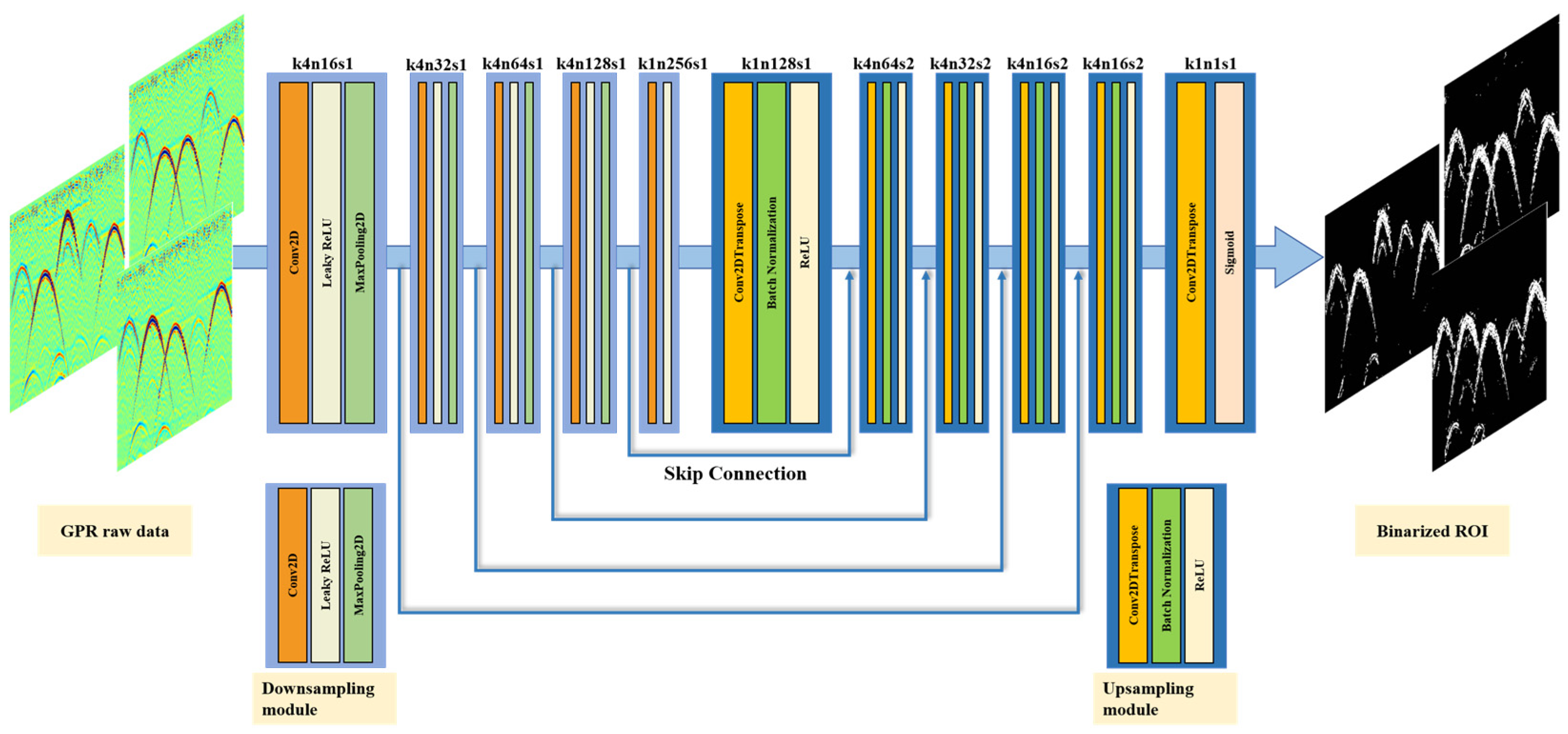
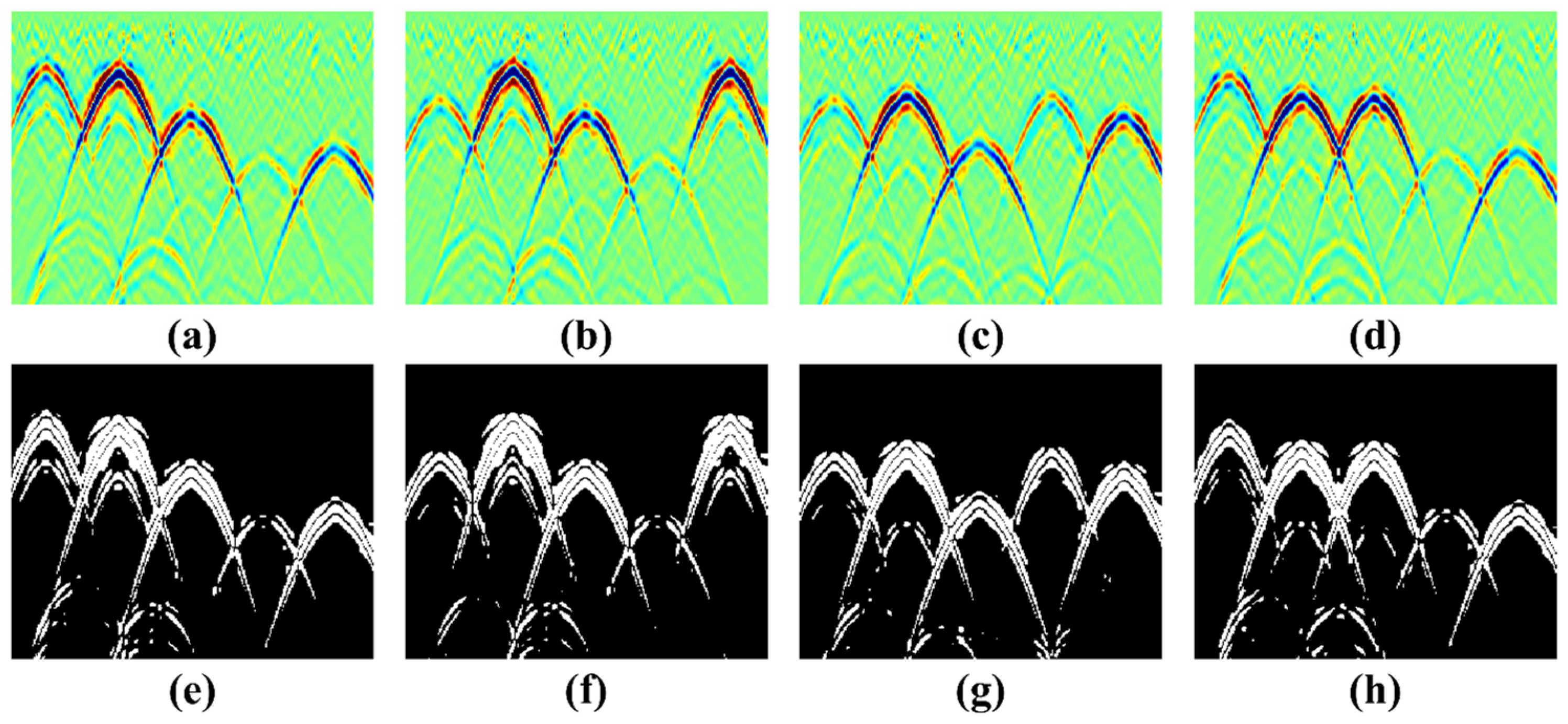
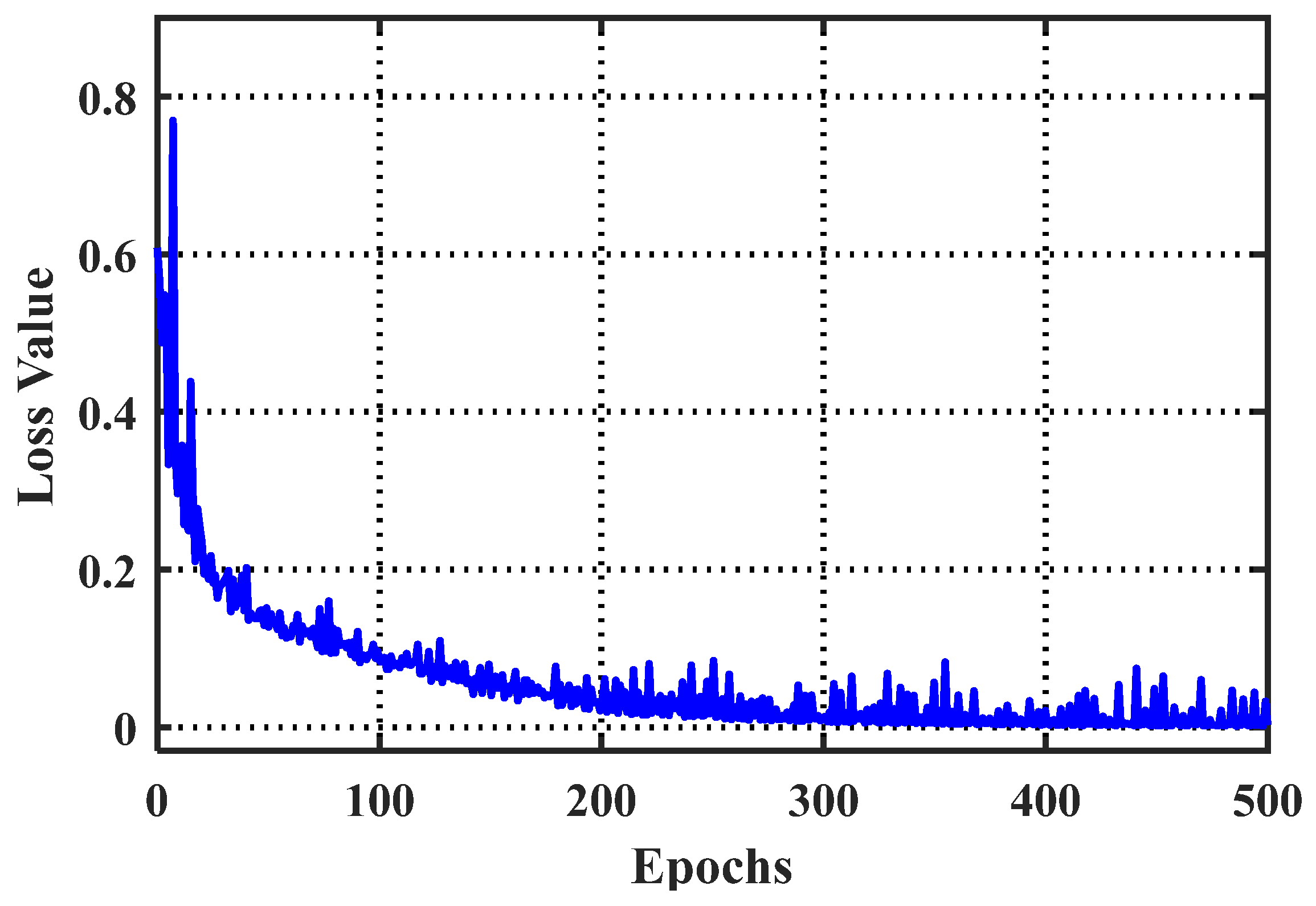

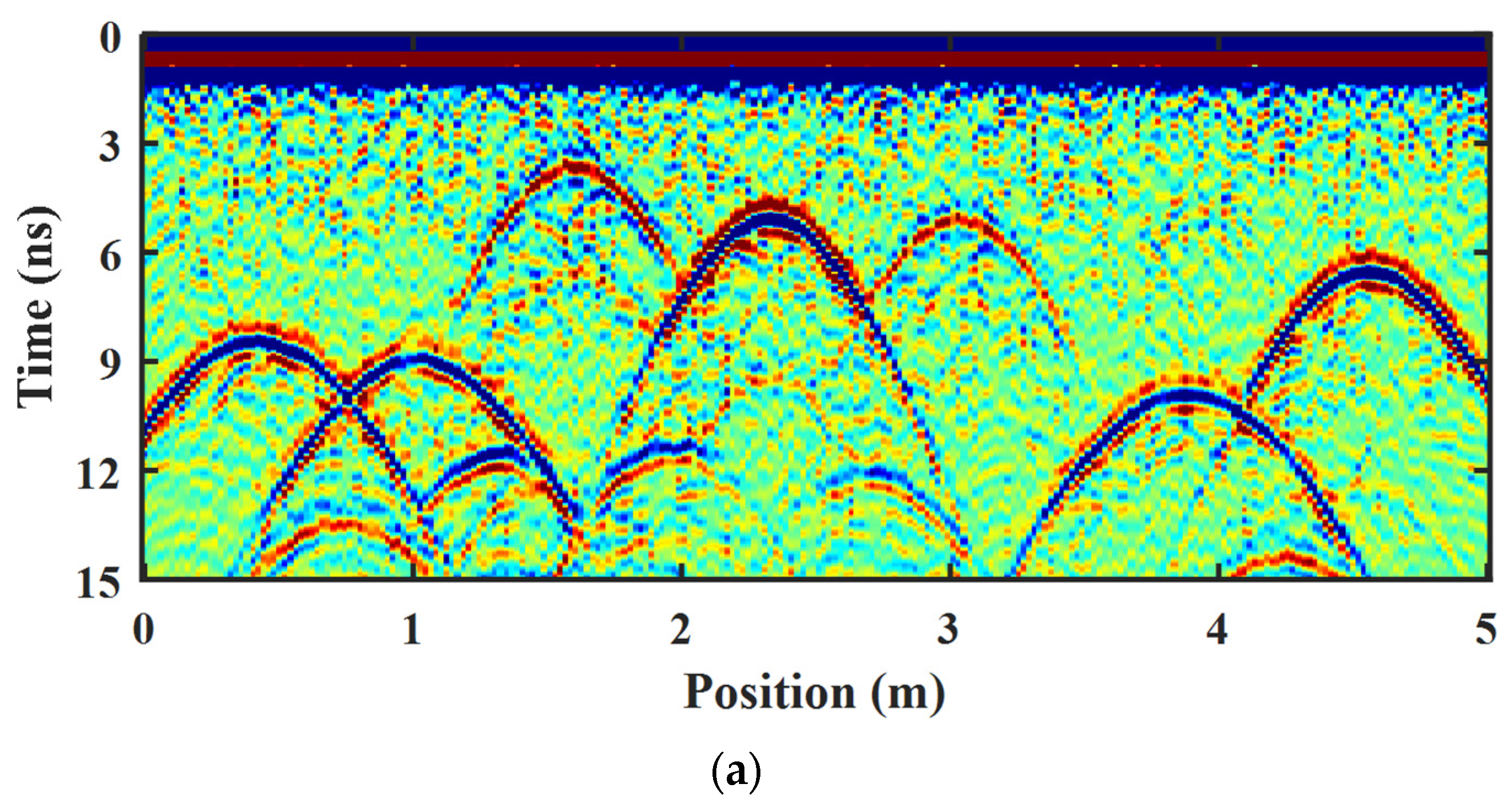
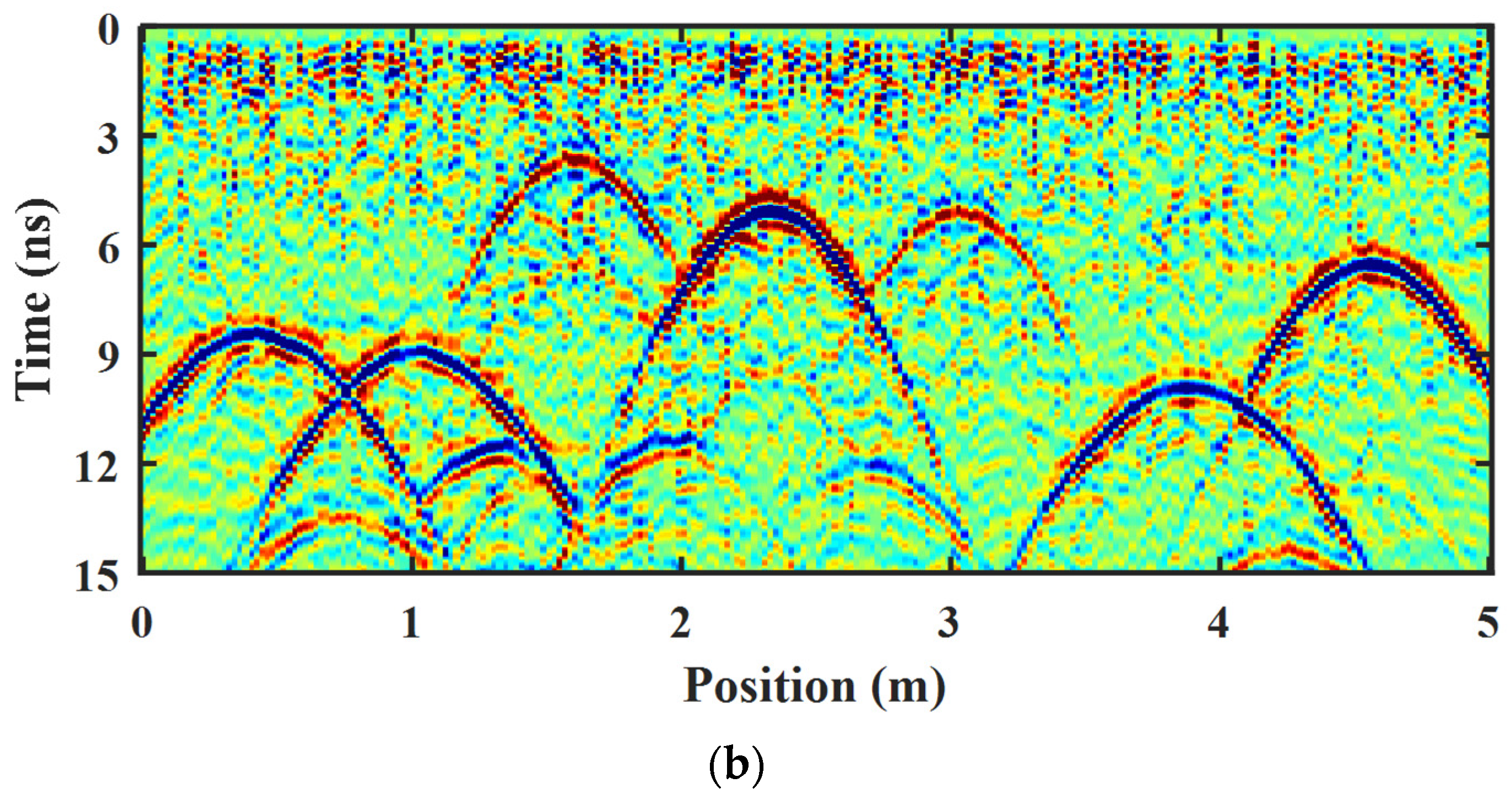
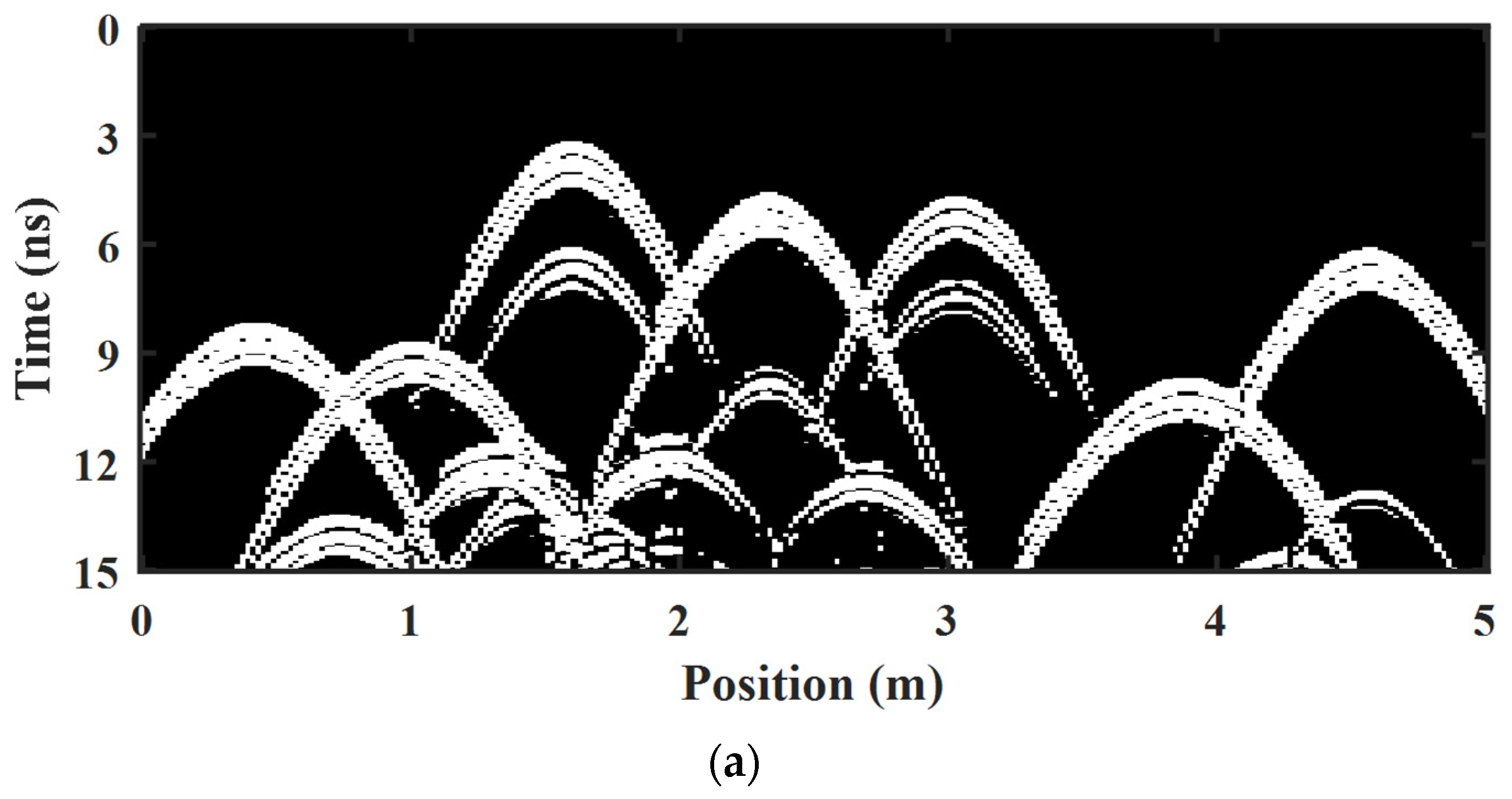
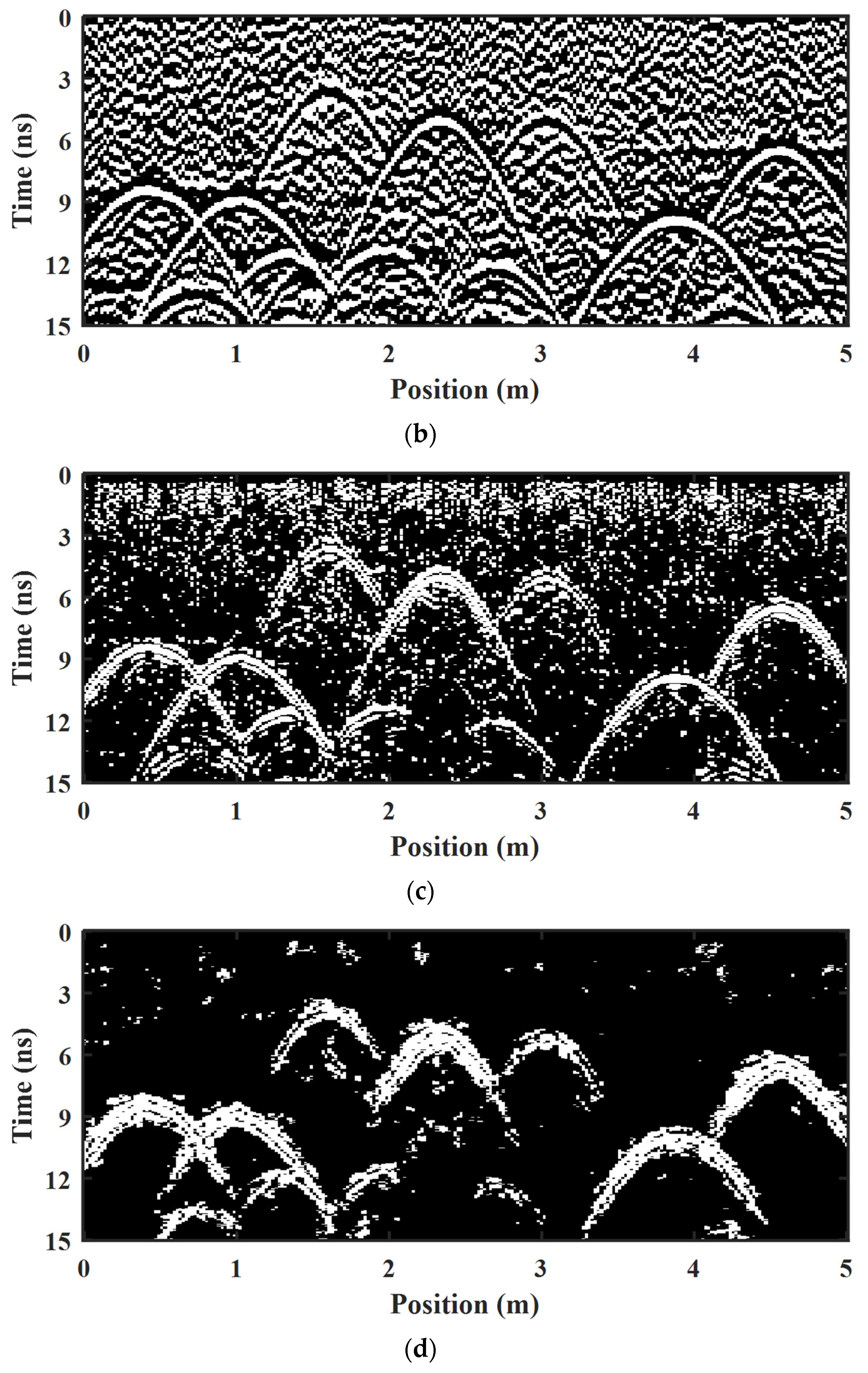
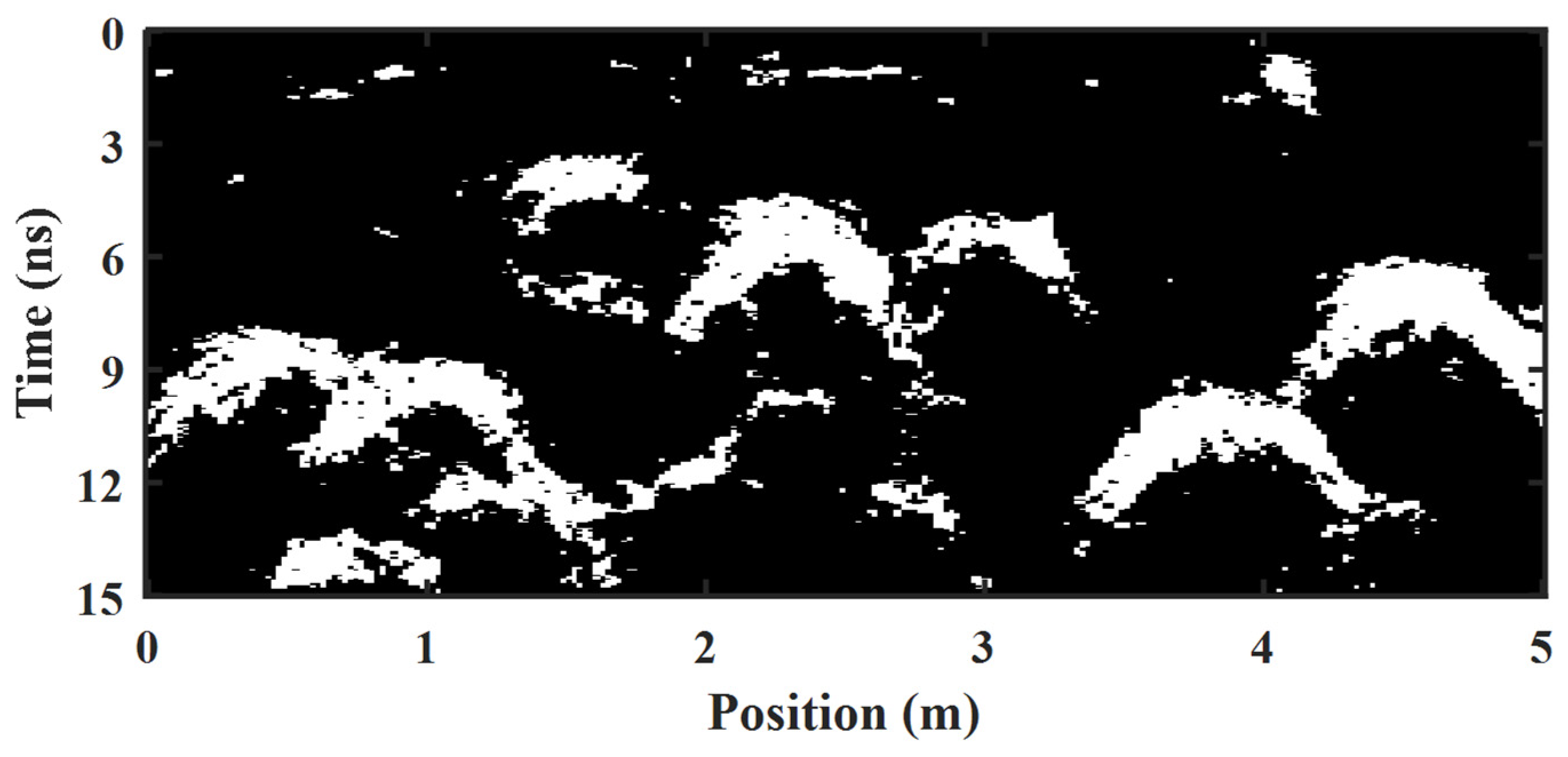

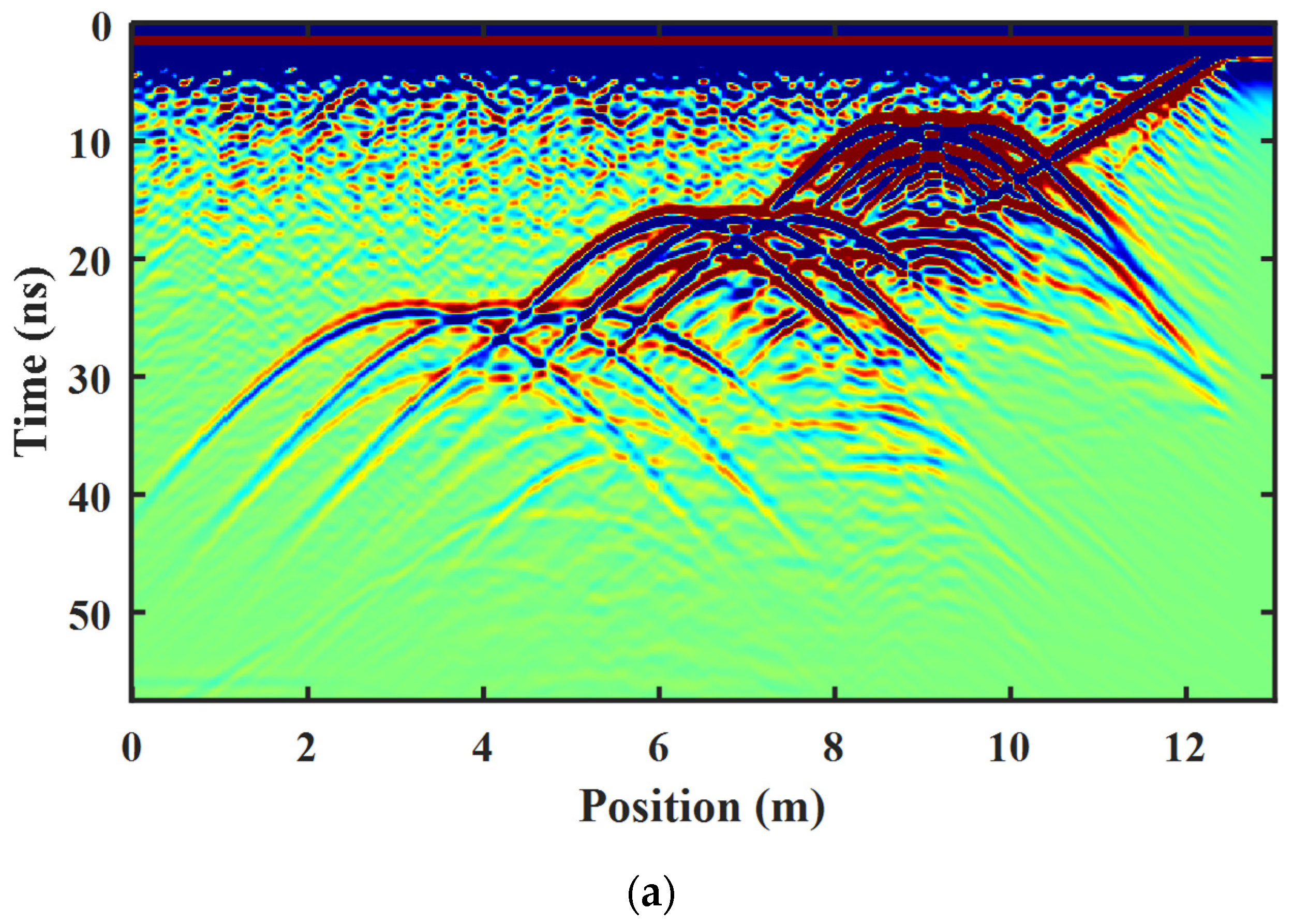

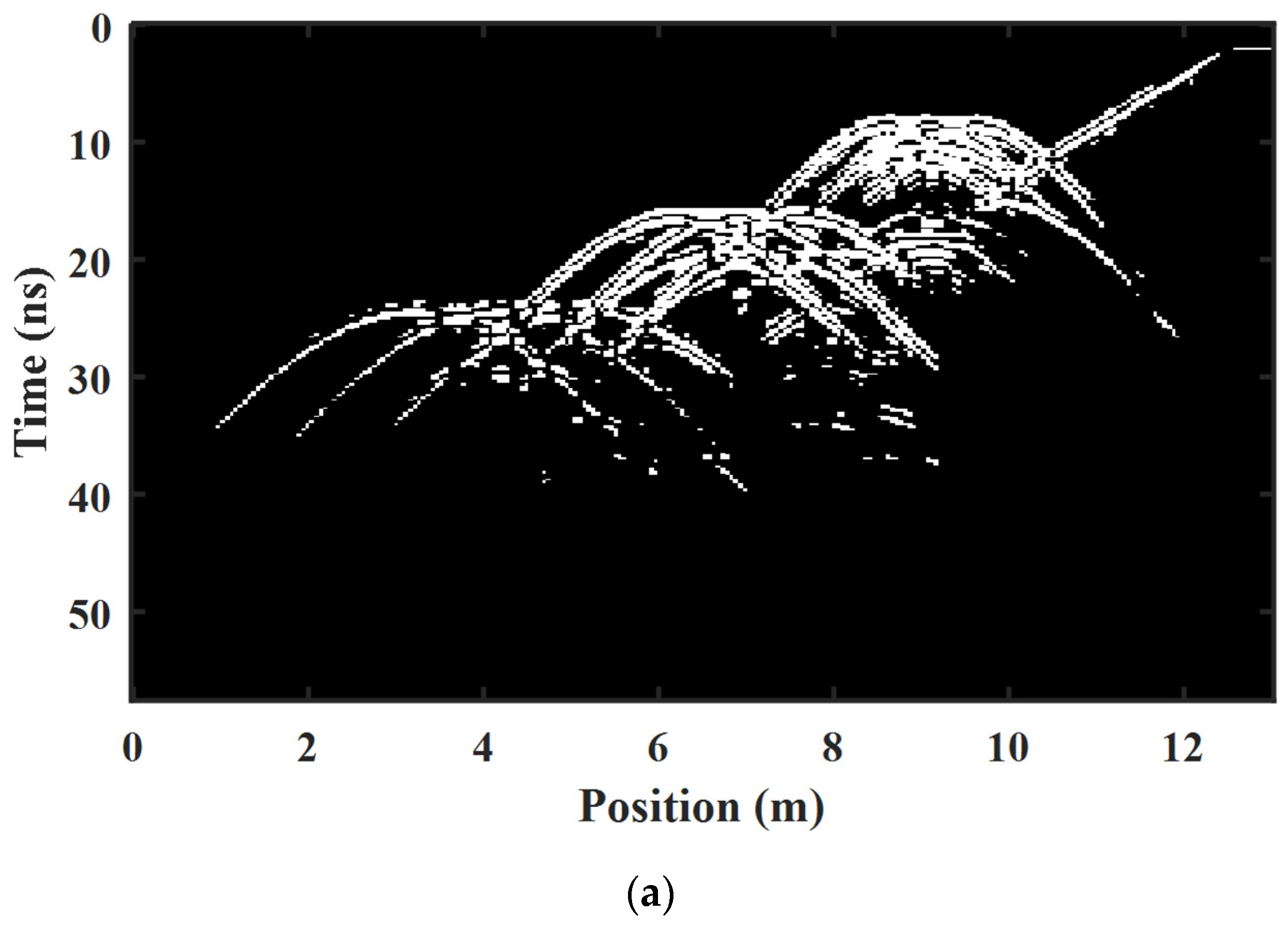
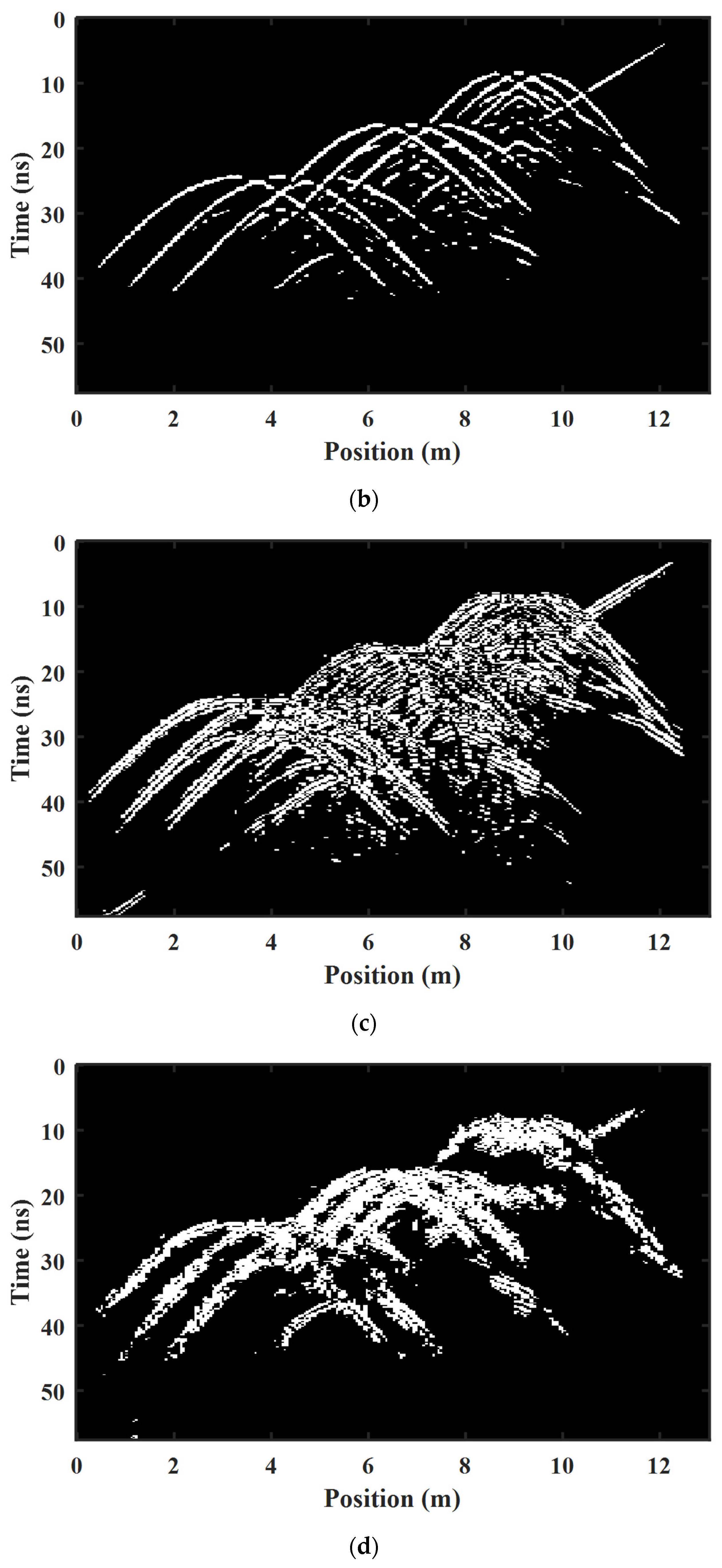
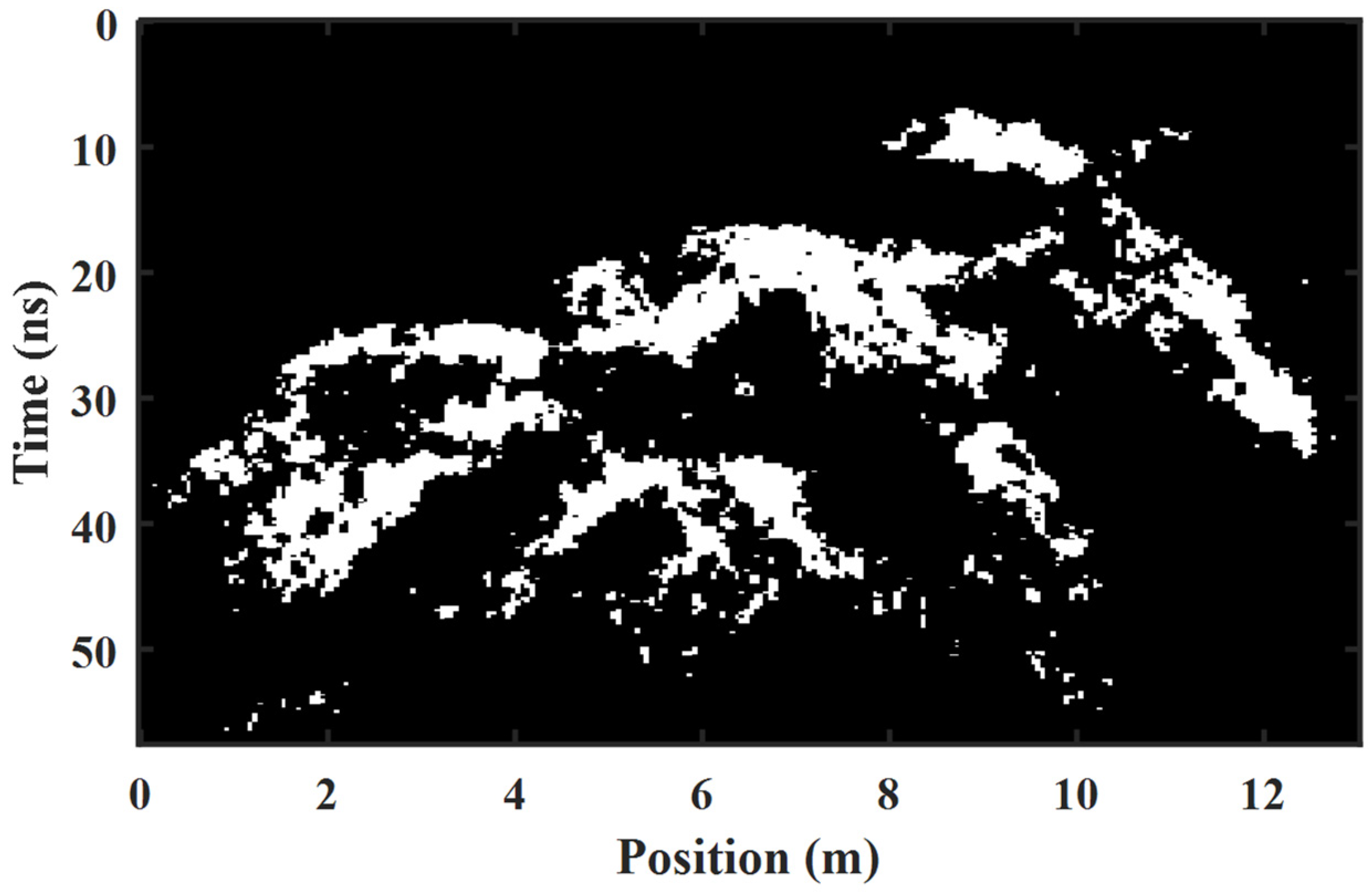
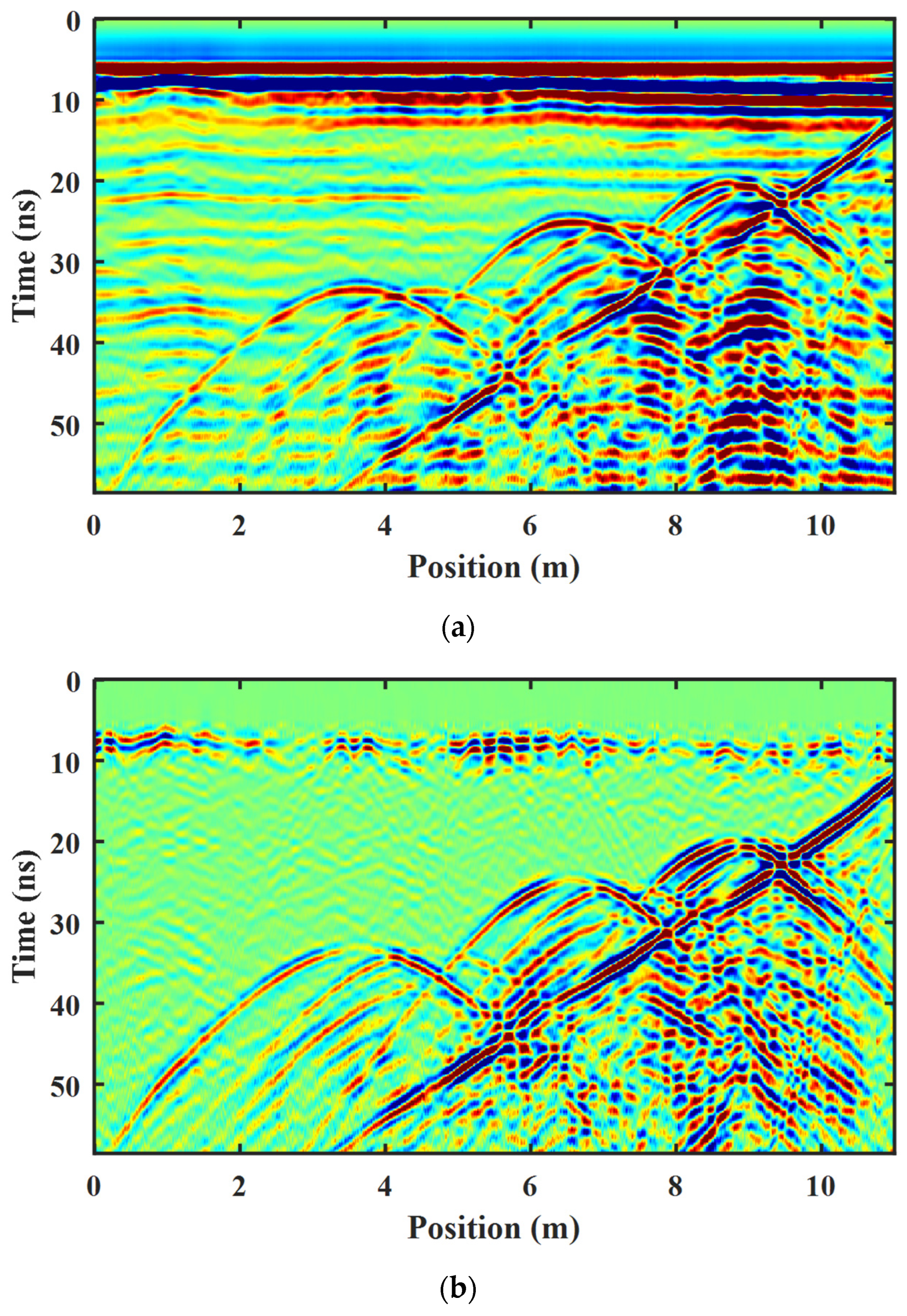
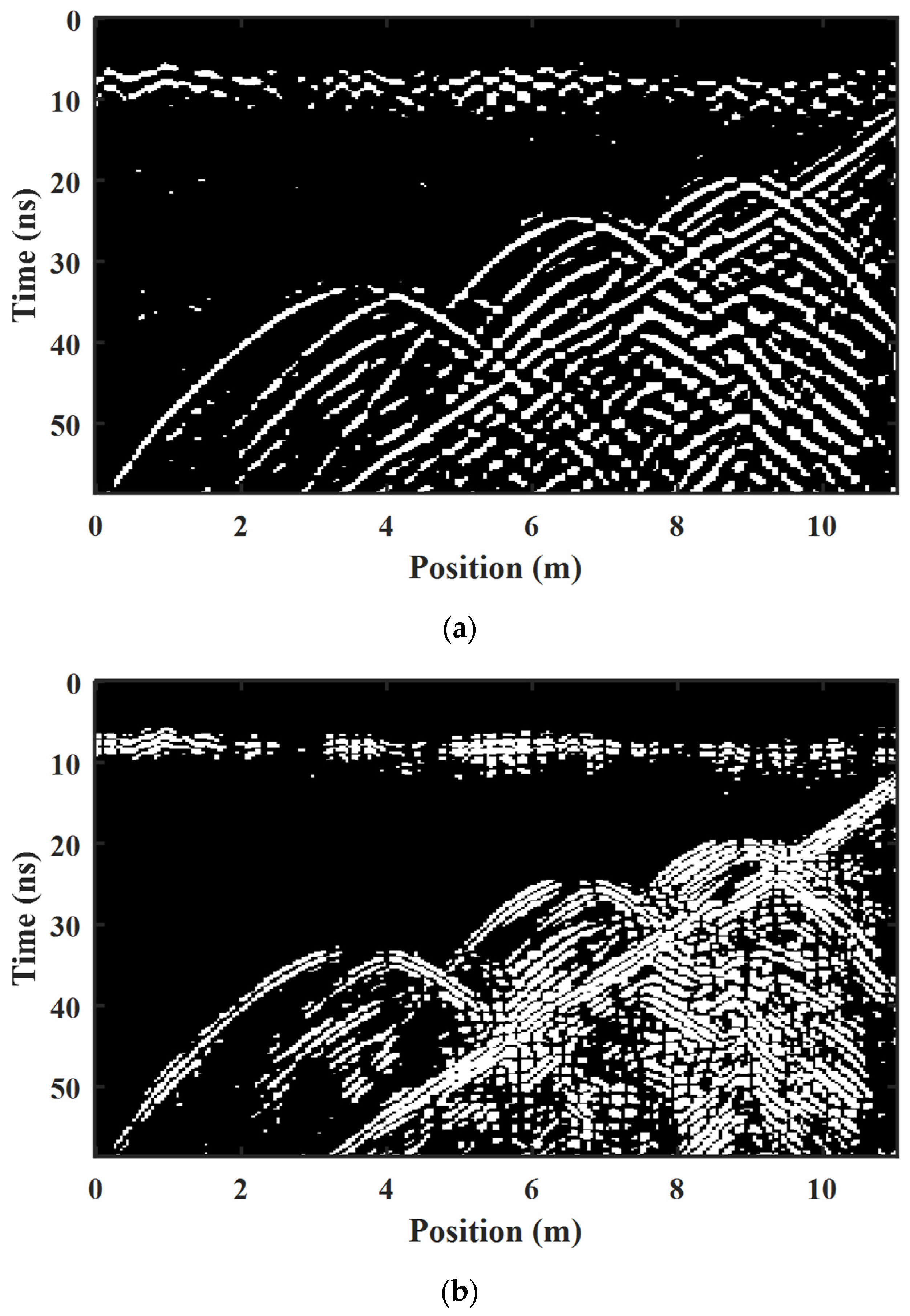

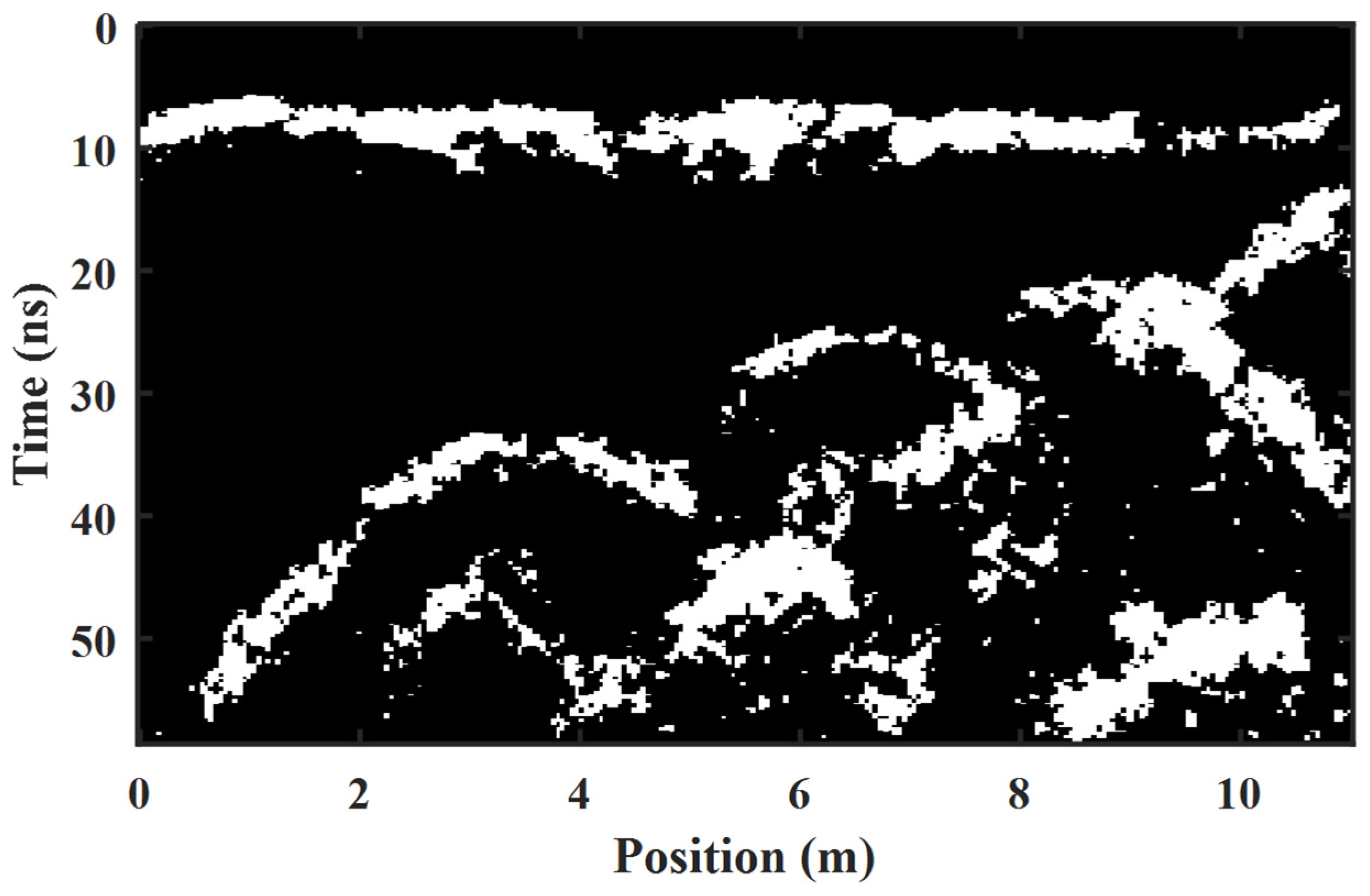
| Pipeline Number | Pipeline Material | Pipeline Outer-Diameter (m) | Pipeline Inner-Diameter (m) | Pipeline Depth (m) |
|---|---|---|---|---|
| I | metal pipeline | 0.200 | 0.180 | 0.600 |
| II | metal pipeline | 0.150 | 0.130 | 0.575 |
| III | PVC | 0.200 | 0.180 | 0.350 |
| IV | metal pipeline | 0.150 | 0.130 | 0.375 |
| V | PVC | 0.150 | 0.130 | 0.375 |
| VI | metal pipeline | 0.200 | 0.180 | 0.675 |
| VII | metal pipeline | 0.150 | 0.130 | 0.450 |
| Strategy | PSNR | SSIM | FSIM |
|---|---|---|---|
| Otsu threshold method | 51.7315 | 0.9530 | 0.8546 |
| K-means clustering segmentation method | 54.2917 | 0.9871 | 0.8706 |
| The Res-CNN method | 57.1894 | 0.9933 | 0.9336 |
| Strategy | PSNR | SSIM | FSIM |
|---|---|---|---|
| Otsu threshold method | 55.7984 | 0.9917 | 0.8428 |
| K-means clustering segmentation method | 58.0648 | 0.9953 | 0.9040 |
| The Res-CNN method | 58.4759 | 0.9958 | 0.9677 |
Disclaimer/Publisher’s Note: The statements, opinions and data contained in all publications are solely those of the individual author(s) and contributor(s) and not of MDPI and/or the editor(s). MDPI and/or the editor(s) disclaim responsibility for any injury to people or property resulting from any ideas, methods, instructions or products referred to in the content. |
© 2024 by the authors. Licensee MDPI, Basel, Switzerland. This article is an open access article distributed under the terms and conditions of the Creative Commons Attribution (CC BY) license (https://creativecommons.org/licenses/by/4.0/).
Share and Cite
Zhang, H.; Dai, Q.; Feng, D.; Wang, X.; Zhang, B. ROI-Binarized Hyperbolic Region Segmentation and Characterization by Using Deep Residual Convolutional Neural Network with Skip Connection for GPR Imaging. Appl. Sci. 2024, 14, 4689. https://doi.org/10.3390/app14114689
Zhang H, Dai Q, Feng D, Wang X, Zhang B. ROI-Binarized Hyperbolic Region Segmentation and Characterization by Using Deep Residual Convolutional Neural Network with Skip Connection for GPR Imaging. Applied Sciences. 2024; 14(11):4689. https://doi.org/10.3390/app14114689
Chicago/Turabian StyleZhang, Hua, Qianwei Dai, Deshan Feng, Xun Wang, and Bin Zhang. 2024. "ROI-Binarized Hyperbolic Region Segmentation and Characterization by Using Deep Residual Convolutional Neural Network with Skip Connection for GPR Imaging" Applied Sciences 14, no. 11: 4689. https://doi.org/10.3390/app14114689
APA StyleZhang, H., Dai, Q., Feng, D., Wang, X., & Zhang, B. (2024). ROI-Binarized Hyperbolic Region Segmentation and Characterization by Using Deep Residual Convolutional Neural Network with Skip Connection for GPR Imaging. Applied Sciences, 14(11), 4689. https://doi.org/10.3390/app14114689









